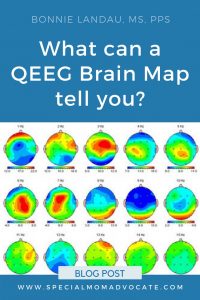 I always hold my breath when an assessment is complete, and when our son had his QEEG brain map I approached the results anxiously. Having been through dozens of these, I still can never get used to hearing what is “wrong” with my son. And so I find I have to focus on deep breaths while listening to the results.
I always hold my breath when an assessment is complete, and when our son had his QEEG brain map I approached the results anxiously. Having been through dozens of these, I still can never get used to hearing what is “wrong” with my son. And so I find I have to focus on deep breaths while listening to the results.
The great thing about our doctor is that she is very reassuring. While telling us what she sees what is not working right, she repeatedly inserts that this information is a good thing because now we know what needs to be improved.
What did the QEEG Brain Map say?
The brain map told us the real source of our son’s issues. It was a key diagnostic tool for us, and it gave us answers we never expected.
- The map confirms that there is some minor brain injury in the right front lobe. That’s where he hit his head on the bookshelf at 1 years old and when he fell off the jungle gym at 4.
- There is a pattern in the center of his brain that could be an indication of a low-grade infection or the result of a prolonged fever. I didn’t even know the brain map would how such a thing. He did have Roto Virus at 8 months of age with a sustained high fever that required emergency intervention to resolve. We believe this caused this pattern in the brain.
- There are irregular patterns in the auditory processing centers, which makes sense he is diagnosed with APD (auditory processing disorder).
- There are too few theta waves. These are the twilight waves that are experienced just before falling to sleep or just before waking up. Makes sense he has a really hard time falling asleep at night.
- There are too many beta waves. This would indicate over activity in the brain. This is why he talks a lot and thinks a lot and sometimes struggles to talk because his thoughts move too fast.
- Combination of too few theta and too many beta would be the reason why he seems like he’s always driven by a motor. It’s actually the opposite brain pattern for ADD which would have high theta and low beta. So this reading rules out ADD as a diagnosis.
- Dr. Blume said his map patterns ruled out autism, dyslexia and ADHD. The results ruled in auditory processing disorder and post-concussive syndrome.
The results of the brain map gave us answers as to the cause of many of the issues. Our next step was neurofeedback, which provided a huge amount of healing to these irregular patterns.


